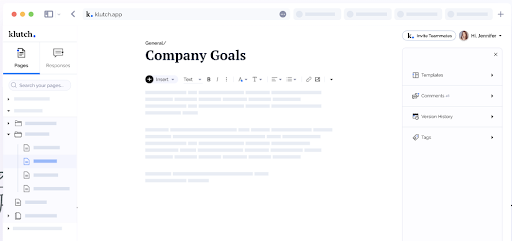Knowledge base software is one of the most powerful tools you can have to capture, codify, and disseminate tacit knowledge. Unlike other types, tacit knowledge can be complicated to share and store, which can cause issues at an organizational level.
Thanks to knowledge base software, however, it’s possible to use plenty of tools to make the most out of tacit knowledge among your employees, making your business/organization run more smoothly.
Let’s cover everything you should know about tacit knowledge and how much it matters in organizations.
What Is Tacit Knowledge?
Tacit knowledge is, in simple terms, the knowledge that you gain from personal experience and/or context. In other words, it’s knowledge that you would probably have trouble articulating or explaining.
Learning how to ride a bike, for example, is a great example of tacit knowledge. Even though there’s a set of standard instructions to follow, you’ll eventually find your own “personal way” of riding it; that’s tacit knowledge.
In the organizational context, tacit knowledge is the one that gets applied according to your company’s needs. Each employee will apply their implicit knowledge differently depending on what’s unique about your business.
If an employee were to create a set of canned answers for clients, for example, they could use their tacit knowledge to adapt these answers to what the company is looking for. This is great if you’re planning on having a knowledge base or FAQ.
What’s the Difference Between Tacit and Explicit Knowledge?
We now know about tacit knowledge, but what about its counterpart?
Unlike tacit knowledge, explicit knowledge is the one you’re able to share or articulate with no issue.
When you capture, process, and interpret data for your business, that would be explicit knowledge. Another example of explicit knowledge would be your company documents, employee handbooks, reports, policy documents, etc.
Tacit knowledge, on the other hand, allows employees to get more context about specific issues and apply unique solutions to them. This is useful if you have team members working in different departments, which makes communication a bit harder.
Explicit knowledge can take your company far, but by applying tacit knowledge to address certain concerns, you’ll be able to take the experience much farther, as well as promote a culture of more efficient knowledge-sharing in your business.
Discover the Most Common Challenges of Capturing Tacit Knowledge
As you may have guessed by now, capturing tacit knowledge isn’t easy. Due to its inherent nature, it can be complicated to figure out how to record personal experiences and contexts for your organization.

There are four primary issues you can expect from capturing tacit knowledge:
- It’s not easy to share: By nature, tacit knowledge is unconscious, so it’s not “readily available” to be shared with other people. An organization led by an intuitive leader, for example, may have trouble guiding future leaders if they can’t share their tacit knowledge.
- It can be limited: Tacit knowledge is born from direct experience, so it will be mostly useful in familiar situations. However, your organization could face new challenges over time, so the knowledge you had in the past may not work today. Your organization needs to learn how to adapt based on that information.
- It can be unreliable: By definition, tacit knowledge comes from unreflective direct experience. This means that, usually, we don’t curate knowledge consciously. If we don’t pay attention to what we learn and adapt it to our organization consciously, we could have trouble down the road.
- It can be a slow process: Tacit knowledge is often vague and ambiguous, so if we don’t capture and decode it consciously over time, it will be harder to adapt it to our organization’s needs.
Even though it may seem hard to capture and share tacit knowledge at first, it doesn’t have to be. By using the right tools, you’ll get many benefits for your organization, including:
- Increased productivity
- Higher competitive advantages
- Better internal communications
- Potential for increased capital
How to Use Knowledge Base to Capture & Share Tacit Knowledge
Having a knowledge base will be the best step you will take toward capturing tacit knowledge. By implementing a few tools we’ll mention here, you’ll be able to transform that knowledge into the most powerful asset of your business.
A knowledge base can help you with many other things, including productivity, written communication, and more. By learning how to use this resource, you can also capture and share knowledge among your organization, allowing your team to make informed decisions and get a better context of everything that’s happening.
Here’s an overview of how you can make the most out of knowledge base software and tacit knowledge:

Identify and Collect Tacit Knowledge from Experts
The best way to start is to identify all the knowledge experts within your organization. This will help you get a deeper insight into which steps to follow and what the best methods to collect tacit knowledge are.
There are many methods to collect tacit knowledge, including observations, interviews, after-action reviews, and more.
A key tool in capturing tacit knowledge is storytelling. Remember that tacit knowledge comes from personal experience. This means that, by allowing your team to share their stories/experiences, you’ll be able to capture the context that was probably missing from certain data.
Structure and Organize Effectively
Once you get the base of the information, you must categorize it to make it easier to share later. By definition, knowledge categorization is a process where all ideas are “recognized, differentiated, and understood.” This will be essential in retrieving tacit knowledge as fast as possible.
A great option you have to organize and structure your tacit knowledge efficiently is to create a user-friendly platform. There, you’ll be able to encourage your team to share knowledge easily and without any technical issues.
The platform you use must be easy to navigate and understand. Otherwise, you’ll put another obstacle toward capturing tacit knowledge in your organization.
Integrate Tacit Knowledge into Knowledge Base Software
Here’s the fun part of the process: You can use knowledge base software to capture tacit knowledge and incorporate it into different content types, allowing your team to access that information much more easily.
For instance, you can create different pages in Klutch that house product findings, marketing experiments or even user stories for your teams to access whenever they need it.

Remember that the key to being successful in sharing tacit knowledge is to use engaging narratives and storytelling to give people context about what you want to say. Presenting case studies, for example, can be an effective method to present and discuss tacit knowledge in a relatable way.
The more identified your team members feel when processing the information, the faster they’ll be able to adapt and use it toward your organizational needs.
If you want to make the most out of tacit knowledge, don’t forget to incorporate it into training materials and/or onboarding processes. This will help you set a better foundation for new members, as well as future managers and leaders.
Promote a Culture of Knowledge Sharing and Utilization
The social aspect of capturing and sharing knowledge is likely the most important one of this guide.
You must create and promote a culture where sharing knowledge is greatly appreciated. This is where having proper leadership in the team is essential, as that person will be responsible for encouraging the rest to identify and capture learning opportunities, allowing them to share them later.
It’s also important to encourage team members to interact and collaborate. When you allow employees to talk about their experiences and skills, you also open the door to a much more intuitive learning process for everyone.
Investing in a knowledge-sharing platform will help you and your team share valuable information much more easily, regardless of how big or small your company is. There are many strategies to consider and apply, including:
- Creating different channels to share knowledge
- Starting forums and meetings
- Offering rewards
- Promoting the sharing of updated and valuable content
If you want to learn how you can encourage your team members to contribute to your knowledge base, check out this article.
Conclusion
Being able to capture and share tacit knowledge will play a huge role in making your organization improve and grow over time. Not only will it help with addressing many tasks, but it could also allow your team to improve their time management, among other benefits.
You can use knowledge base software like Klutch to capture and share your team’s tacit knowledge more efficiently, allowing you to make the most out of all your assets. The platform also allows you to streamline any other knowledge base needs you may have in mind.
If you’re aiming for more efficiency and success in your organization, consider implementing this software today and exploring more about the world of knowledge management. It will help your company more than you may think.



